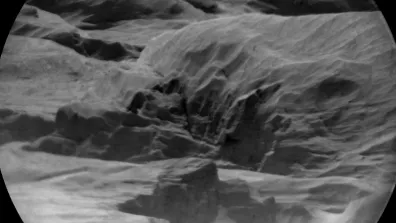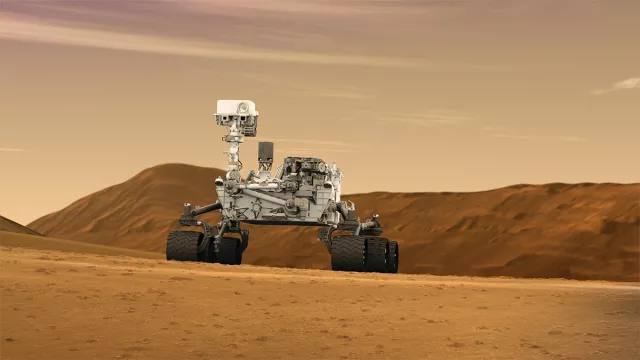On 6 August 2012, the Curiosity rover landed on Mars to determine if the red planet could once have harboured life. CNES is closely involved in this mission led by NASA, which has been extended several times beyond its nominal 22-month lifetime.
Key information
| Mission | Characterization of Mars’ geology, analysis of its climate and determination of its past habitability |
|---|---|
| Domain | Science |
| Launch date | 26 November 2011, landed 6 August 2012 |
| Partners | NASA, LATMOS, IRAP, CNRS, French universities, LANL |
| Where | Surface of Mars (Gale Crater) |
| Lifetime | 1 Martian year, i.e. 687 Earth days (669 sols) |
| Status | In operation |
Key figures
- 900 kg: rover mass
- 10 instruments
- 2 French-U.S. instruments
- 2.9 x 2.7 x 2.2 m: rover dimensions
Key milestones
- September 2025: Latest mission extension decided by NASA
- 6 August 2012: Curiosity rover lands in Gale Crater, Mars
- 25 November 2011: MSL launched by Atlas V 541
- July 2011: Gale Crater selected as landing site for Curiosity
- August 2010: ChemCam instrument delivered to JPL
- 27 May 2009: MSL mission rover named Curiosity
- 2006: Start of phase C/D of mission development
- 2005: Start of phase A of mission development
- 2004: MSL project kick-off
Project in brief
Was Mars once habitable? That’s the main question the Mars Science Laboratory (MSL) mission of NASA’s Mars exploration programme is attempting to answer with the Curiosity rover operating on the planet’s surface. Since landing on 6 August 2012 in Gale Crater, this 900-kg robotic explorer has conducted a wealth of analyses aimed at assessing Mars’ habitability, estimating its biological potential and characterizing its geology.
Curiosity has already determined that conditions on Mars were once conducive to life, discovered an ancient river bed but failed to detect any methane, a gas released by certain living organisms on Earth that would have strengthened the likelihood of lifeforms existing on Mars.
Curiosity is carrying 10 instruments, two of them joint French-U.S. efforts.
The first, ChemCam, was designed and developed in France and the United States. The instrument was chosen to determine the chemical composition of Martian rocks in the rover’s vicinity, by analysing the flash of light generated by a laser beam hitting their surface, a technique called laser-induced breakdown spectroscopy (LIBS). This works by heating a tiny point—smaller than one square millimetre—on the rock to more than 10,000°C to vaporize it into a plasma state. The rock’s atomic composition is then determined through spectral analysis of the light flash to enable scientists to deduce what it is.
This project is the result of a team effort by more than 300 people in France—at the national scientific research centre CNRS, universities, CNES and in industry—with the IRAP astrophysics and planetology research institute as technology and science lead, in partnership with Los Alamos National Laboratory (LANL, USA) and overseen by CNES, which funded the French contribution.
The second, SAM (Sample Analysis at Mars), is a large analytical chemistry laboratory. It’s the largest instrument on the mission, tipping the scales at nearly 40 kilograms, half the rover’s payload mass. Its role is to analyse the rover’s environment at molecular level. It’s also a French-U.S. effort, the result of the work of some 100 people in France—at CNRS, universities, CNES and in industry—led by the LATMOS atmospheres, environments and space observations laboratory and CNES. It was developed in partnership with NASA’s Goddard Space Flight Center (GSFC) and Jet Propulsion Laboratory (JPL). SAM is able to heat rock samples collected by the rover up to more than 850°C and finely analyse the chemical make-up of gases released with three complementary in-built instruments. These analyses yield information about the nature of materials and organic compounds in the samples. SAM also has the ability to analyse the composition of the atmosphere to better understand Mars’ present and past climate.
CNES’s role
CNES is contributing to the mission in four areas:
- As contracting authority for the ChemCam instrument, developed by IRAP and LANL (USA)
- Funding for the French contribution to the ChemCam project
- Co-development of the SAM instrument with LATMOS, NASA Goddard Space Flight Center and NASA Jet Propulsion Laboratory.
- For more than 11 years now, the FOCSE (French Operations Centre for Science and Exploration) at CNES’s Toulouse Space Centre has accommodated French teams working with NASA teams on alternate weeks. Every evening, the engineers and scientists operating ChemCam and SAM monitor the instruments and uplink their work plans, and retrieve and process science data.
Contacts
CNES Project Leader and FOCSE Manager
Valérie Mousset
E-mail: valerie.mousset at cnes.fr
Solar System Planets and Small Bodies subject matter expert
Francis Rocard
E-mail: francis.rocard at cnes.fr
Project news



